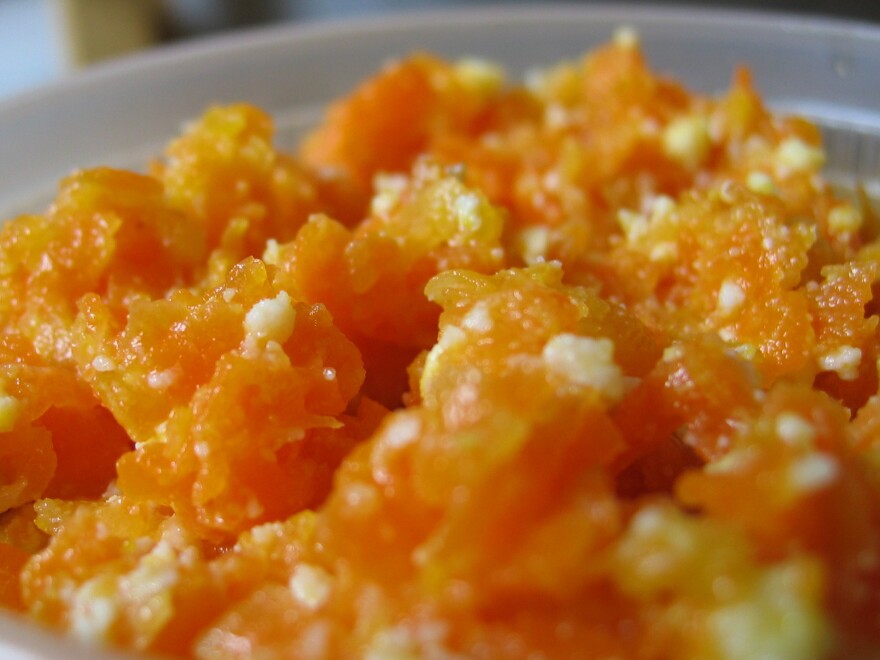In Indian kitchens, patience is a virtue.
Vegetables must be chopped, lentils soaked, spices roasted and ground before slowly simmering everything together. If you try to cut corners, the food just isn't the same.
The same is true for some relationships.
My mother-in-law, Rama Saini, grew up in north India in the early years after independence from the British. At age 19, her marriage was arranged and she moved to Canada with her husband. By 30 she had three children and a thriving business.
I'm a white girl from Wyoming and South Dakota, where Indian culture usually has more to do with Crazy Horse than Gandhi. I came east and went to college, then graduate school. I'm 33 now and I still don't know how to change a diaper.
When we met almost a decade ago, my mother-in-law and I had so much more than a generational gap to bridge. But we could cook together, and we filled the silences with talk of spices and recipes.
She was probably expecting a daughter-in-law who spoke Punjabi or at least knew Indian culture.
In those early years, everything – the ingredients, their aromas, the names of the dishes – was new to me. I loved my mother-in-law's cooking that first weekend when I met her, and let her know that I wanted to learn how to cook her dishes.
Cooking was an easy way "in" for someone who had no prior knowledge of South Asia. I would hover over her shoulder as she cooked, asking questions and scribbling notes.
It took me years to master the basics. But my mother-in-law patiently guided me through her recipes, teaching me how to make roti (griddled flatbread), daal (lentil soups), and sabzi (vegetables cooked with different combinations of spices and seasonings).
I learned to wield spices like cumin, garam masala, fenugreek and turmeric. And I discovered that I loved the fresh, piercing heat of the tiny green chilies used in Indian cooking.
I was also absorbing subtler lessons about the role of a young daughter-in-law in an Indian family. Growing up in South Dakota and Wyoming, independence and self-sufficiency had been prized. But now I was learning how to rely on family – and be relied upon.
There were new obligations, sometimes to relatives I'd never even met. And there was no shortage of unsolicited advice. Occasionally I struggled to muzzle my feminist inclinations in order to keep the peace.
At times it seemed like my mother-in-law and I might never understand each other – but we kept cooking together.

One Thanksgiving I showed my mother-in-law how to bake apple pie, using my grandmother's recipe. In turn, she has shared some of her specialties with me: kadhi (a tangy yogurt stew) and paranthas (stuffed flatbreads). This spring she taught me how to make her favorite sweet dish, gajar ka halwa – a creamy pudding of grated carrots cooked down with milk and sugar.
It turns out, the secret to good halwa is waiting. As the carrots cook and the water slowly dries up, you must watch and stir – looking for the right moment to add the finishing touch: freshly ground cardamom.
My mother-in-law and I didn't have an exact recipe to follow as we forged our relationship, but somehow we understood that time and patience would pay off for us, too.
Hear us cooking together here.
Recipe: Rama Saini's Gajar ka Halwa
4 pounds carrots, grated
1 cup water
1 cup sugar (alternative: South American panela or Indian jaggery)
1 tablespoon butter
1/3 cup golden raisins
1/2 cup slivered almonds
3 cups powdered milk (alternative: Indian khoya)
4 pods of cardamom – seeds only, ground (alternative: 1 teaspoon pre-ground cardamom)
In a food processor, grate the carrots. (Or you can grate them by hand, if you want a workout.) Transfer the grated carrots to a large pot and add water. Turn heat to medium-low and cover the pot. Stir every 10 minutes until all the moisture cooks away (30 to 45 minutes).
Add sugar and butter, stir thoroughly, and cover pot until all the moisture from the sugar cooks away (5 to 10 minutes). Add raisins, stir thoroughly, and cover pot for 5 minutes.
Add almonds and powdered milk. Lower heat and stir continuously until all the moisture cooks away (5 to 10 minutes).
Turn off heat, add cardamom, and stir gently. (Note: If you're using whole pods of cardamom, remove the shell and grind the seeds in a mortar and pestle first.)
Serve warm. Leftovers can be stored in the refrigerator for a week.
Copyright 2020 NPR. To see more, visit https://www.npr.org. 9(MDAyNDY5ODMwMDEyMjg3NjMzMTE1ZjE2MA001))




